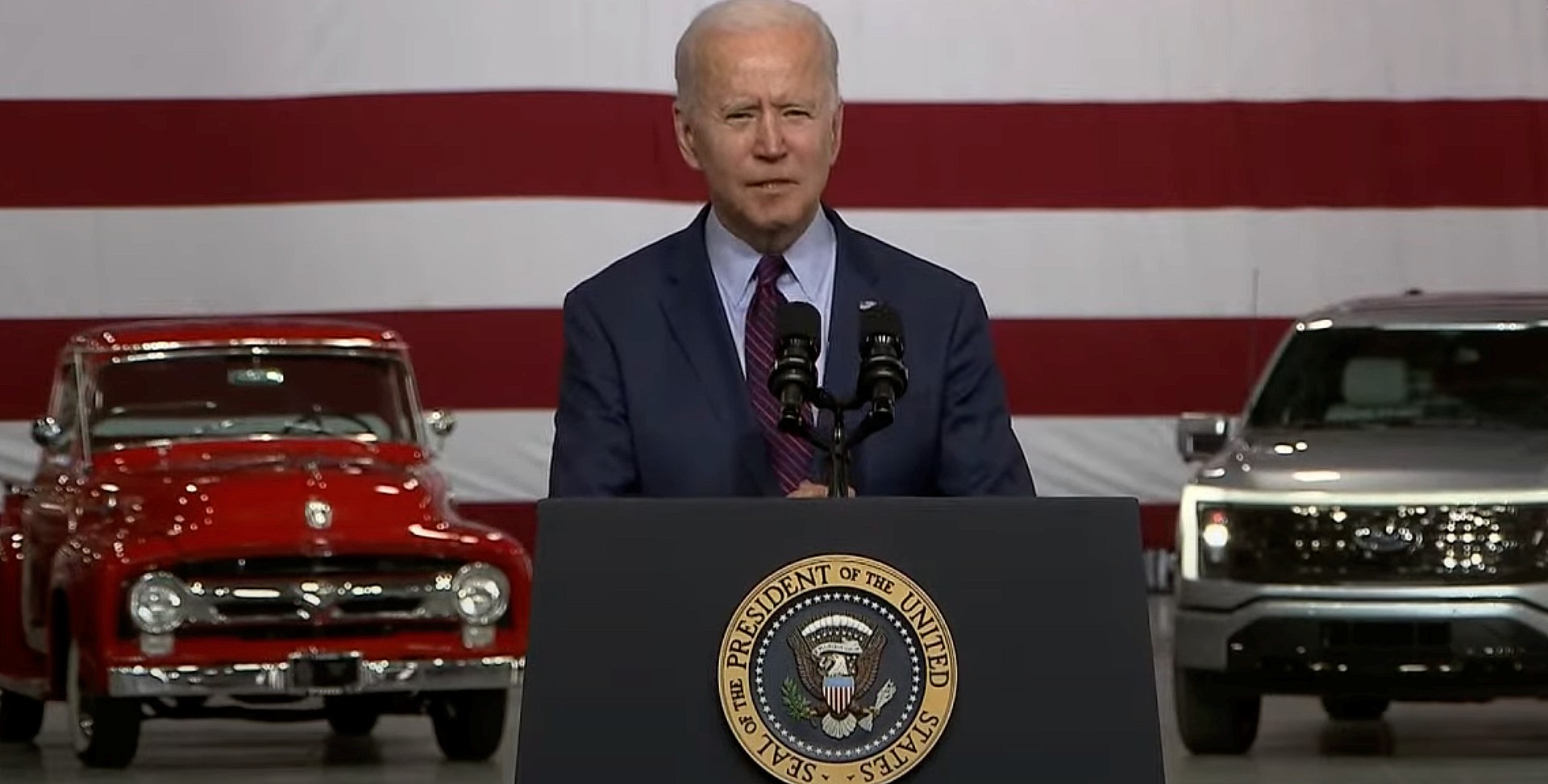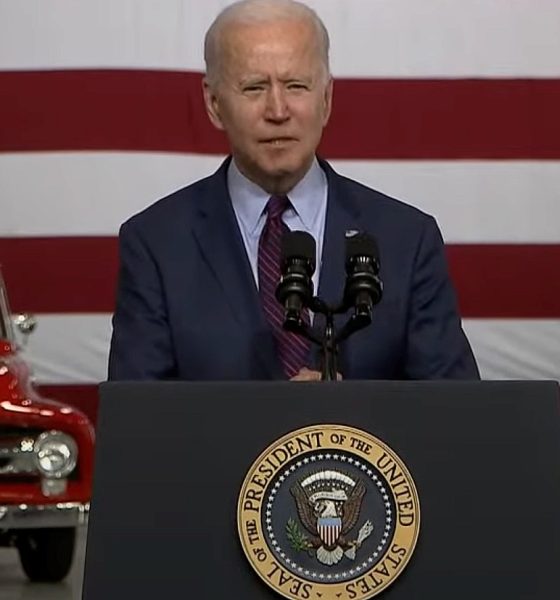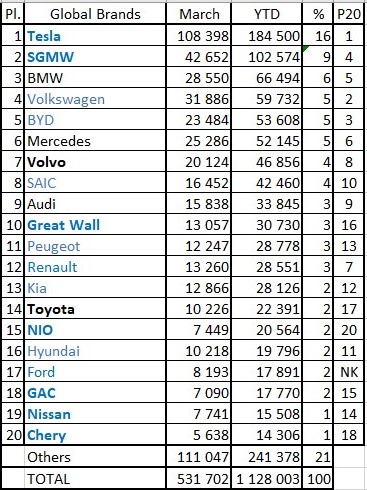

News
President Joe Biden’s Tesla-void EV speech gave Ford too much credit [Opinion]
Earlier today, President Joe Biden spoke at Ford Motor Company’s Dearborn plant in Dearborn, Michigan, with intentions of delivering more details regarding his plans to expand the EV sector in the United States through a more broad charging infrastructure, freely unionized manufacturing jobs, and a heavily supportive dialogue that failed to include any details on companies that are pushing electrification forward, like Tesla. In my opinion, it showed that the President doesn’t have a broad understanding of electrification. While that’s okay, his position as President of the United States requires more comprehension on subjects that involve reducing emissions and increasing the number of EVs on the road, a direct factor in the reduction of greenhouse gases entering the atmosphere.
His speech gave Ford entirely too much credit, especially as the main essence was combining EV production with unionized jobs for U.S. workers.
In the speech, President Biden commended Ford for its extensive history of automotive legacy, something that nobody can deny. Ford has a rich history when it comes to cars, and some of its vehicles are still the best and most popular on the market. Two of the four vehicles I have owned have been Fords, the most recent being a 2008 Ford Escape Hybrid. It was the best car I’ve ever had. My Dad has owned nothing but Fords for as long as I can remember.
President Biden was increasingly concerned about the number of jobs that could be offered to U.S. workers or whether American companies would have to depend on foreign countries to build and produce EVs. It simply wasn’t an option for the American economy, the President hinted. Ironically, his speech took place at a facility owned by a company that outsourced its first mass-market electric vehicle production to Mexico.
With Ford entering the EV sector with the Mustang Mach-E, it opened up a favorable introduction into the industry for the company that Henry Ford started in 1903. The vehicle is safe and was awarded an IIHS Top Safety Pick award, and has received favorable reviews from owners thus far. Despite minor issues early on related to software, the Mustang Mach-E undoubtedly has a bright future in the sector and will likely be one of the company’s most popular vehicles for the coming years. But it’s not going to throw Ford into EV superstardom, especially not with the U.S.-produced tune that Biden spoke highly of during his speech. The vehicle is actually built at the Cuautitlán Assembly Plant in Cuautitlán Izcalli, Mexico.
That’s not going to help the American economy, nor will it supply U.S. workers with union jobs that Biden talked so much about during his speech.
The issue is, Biden seemed to give Ford credit for things that they’re just not very well-versed with quite yet. President Biden mentioned during the speech that the United States was falling behind China in terms of EV tech and battery cell efficiency. “Right now, China is leading in this race. Make no bones about it. It’s a fact.” The problem is this just simply is not true.
An American company is winning this race. An American company is dominating this race. An American company is growing its employment force hand over fist on an annual basis. An American company had the most popular electric car in China last year.
It was Tesla.
The issue with this is that America is in the lead when it comes to EVs. It is in the lead when it comes to EV batteries, and employment isn’t an issue for the company that continues to dominate the electric vehicle sector as a whole. Tesla is the benchmark for all three of these subcategories: overall EV performance, EV battery tech, and employment.
Tesla’s electric vehicles are the leader of the industry. With performance and range ratings that sit well above any other vehicle on the market, there is no secret why the company continues to be held to such a high standard. Recent data compiled by the EV Sales Blog shows that Tesla was the most popular EV OEM through Q1 2021, leading the partnership between SAIC, GM, and Wuling by nearly 82,000 units. Tesla sold roughly 184,500 cars through Q1. SAIC-GM-Wuling sold 102,574.
Ford was 17th, with 17,891 units sold in Q1.
Credit: EV Sales Blog
In batteries, Tesla’s 2170 cells come from Panasonic in Nevada at Tesla’s Gigafactory in Sparks. It is currently developing the 4680 cell, which will provide more power, range and decrease production costs by a significant margin. Tesla is effectively on the verge of decreasing electric vehicle costs by a significant margin, and in a few years, it expects to build a $25,000 car that will reach price parity with gas-powered rivals. While Biden spoke highly of Ford’s Georgia-based battery production plans for the electric F-150, he didn’t mention Tesla’s production of the 2170 cells in Nevada, nor did he mention the massive project at Kato Road in Northern California, just a stone’s throw away from Tesla’s Fremont Factory. This building is where Tesla is developing the 4680 cells, and it is rumoredly a Top 10 capacity cell manufacturing facility in the world.
Tesla’s 4680 Kato Rd. facility has a top 10 capacity, and it’s not even close to finished
While Biden’s enthusiasm for electric vehicles seems to be evident, it appears that the President needs a crash course in the world of EVs. It is rather bothersome to hear our President give zero credit to the American EV powerhouse Tesla, and while I can understand that Tesla may be on the list of banned words during a speech at Ford factories, it is a scare tactic to state that it’s an absolute fact that China is kicking our butts in EV development.
Make no bones about it, President Biden. It’s a fact that Tesla is leading this race. It’s not a close one at the current time, either.
I would love to see Biden make his way to Northern California for a tour of the Fremont Factory, or even a talk with Elon Musk regarding what Tesla is doing for the planet in terms of EV production. As Tesla has taken a commanding lead in the sector, legacy automakers have been forced to oblige and adapt to the changing industry. It is no coincidence that when these companies talk about who they are gunning for, Tesla is atop the list.

Elon Musk
Elon Musk’s X will start using a Tesla-like software update strategy
The initiative seems designed to accelerate updates to the social media platform, while maintaining maximum transparency.

Elon Musk’s social media platform X will adopt a Tesla-esque approach to software updates for its algorithm.
The initiative seems designed to accelerate updates to the social media platform, while maintaining maximum transparency.
X’s updates to its updates
As per Musk in a post on X, the social media company will be making a new algorithm to determine what organic and advertising posts are recommended to users. These updates would then be repeated every four weeks.
“We will make the new 𝕏 algorithm, including all code used to determine what organic and advertising posts are recommended to users, open source in 7 days. This will be repeated every 4 weeks, with comprehensive developer notes, to help you understand what changed,” Musk wrote in his post.
The initiative somewhat mirrors Tesla’s over-the-air update model, where vehicle software is regularly refined and pushed to users with detailed release notes. This should allow users to better understand the details of X’s every update and foster a healthy feedback loop for the social media platform.
xAI and X
X, formerly Twitter, has been acquired by Elon Musk’s artificial intelligence startup, xAI last year. Since then, xAI has seen a rapid rise in valuation. Following the company’s the company’s upsized $20 billion Series E funding round, estimates now suggest that xAI is worth tens about $230 to $235 billion. That’s several times larger than Tesla when Elon Musk received his controversial 2018 CEO Performance Award.
As per xAI, the Series E funding round attracted a diverse group of investors, including Valor Equity Partners, Stepstone Group, Fidelity Management & Research Company, Qatar Investment Authority, MGX, and Baron Capital Group, among others. Strategic partners NVIDIA and Cisco Investments also continued support for building the world’s largest GPU clusters.
News
Tesla FSD Supervised wins MotorTrend’s Best Driver Assistance Award
The decision marks a notable reversal for the publication from prior years, with judges citing major real-world improvements that pushed Tesla’s latest FSD software ahead of every competing ADAS system.

Tesla’s Full Self-Driving (Supervised) system has been named the best driver-assistance technology on the market, earning top honors at the 2026 MotorTrend Best Tech Awards.
The decision marks a notable reversal for the publication from prior years, with judges citing major real-world improvements that pushed Tesla’s latest FSD software ahead of every competing ADAS system. And it wasn’t even close.
MotorTrend reverses course
MotorTrend awarded Tesla FSD (Supervised) its 2026 Best Tech Driver Assistance title after extensive testing of the latest v14 software. The publication acknowledged that it had previously criticized earlier versions of FSD for erratic behavior and near-miss incidents, ultimately favoring rivals such as GM’s Super Cruise in earlier evaluations.
According to MotorTrend, the newest iteration of FSD resolved many of those shortcomings. Testers said v14 showed far smoother behavior in complex urban scenarios, including unprotected left turns, traffic circles, emergency vehicles, and dense city streets. While the system still requires constant driver supervision, judges concluded that no other advanced driver-assistance system currently matches its breadth of capability.
Unlike rival systems that rely on combinations of cameras, radar, lidar, and mapped highways, Tesla’s FSD operates using a camera-only approach and is capable of driving on city streets, rural roads, and freeways. MotorTrend stated that pure utility, the ability to handle nearly all road types, ultimately separated FSD from competitors like Ford BlueCruise, GM Super Cruise, and BMW’s Highway Assistant.
High cost and high capability
MotorTrend also addressed FSD’s pricing, which remains significantly higher than rival systems. Tesla currently charges $8,000 for a one-time purchase or $99 per month for a subscription, compared with far lower upfront and subscription costs from other automakers. The publication noted that the premium is justified given FSD’s unmatched scope and continuous software evolution.
Safety remained a central focus of the evaluation. While testers reported collision-free operation over thousands of miles, they noted ongoing concerns around FSD’s configurable driving modes, including options that allow aggressive driving and speeds beyond posted limits. MotorTrend emphasized that, like all Level 2 systems, FSD still depends on a fully attentive human driver at all times.
Despite those caveats, the publication concluded that Tesla’s rapid software progress fundamentally reshaped the competitive landscape. For drivers seeking the most capable hands-on driver-assistance system available today, MotorTrend concluded Tesla FSD (Supervised) now stands alone at the top.
News
Elon Musk’s Grokipedia surges to 5.6M articles, almost 79% of English Wikipedia
The explosive growth marks a major milestone for the AI-powered online encyclopedia, which was launched by Elon Musk’s xAI just months ago.

Elon Musk’s Grokipedia has grown to an impressive 5,615,201 articles as of today, closing in on 79% of the English Wikipedia’s current total of 7,119,376 articles.
The explosive growth marks a major milestone for the AI-powered online encyclopedia, which was launched by Elon Musk’s xAI just months ago. Needless to say, it would only be a matter of time before Grokipedia exceeds English Wikipedia in sheer volume.
Grokipedia’s rapid growth
xAI’s vision for Grokipedia emphasizes neutrality, while Grok’s reasoning capabilities allow for fast drafting and fact-checking. When Elon Musk announced the initiative in late September 2025, he noted that Grokipedia would be an improvement to Wikipedia because it would be designed to avoid bias.
At the time, Musk noted that Grokipedia “is a necessary step towards the xAI goal of understanding the Universe.”
Grokipedia was launched in late October, and while xAI was careful to list it only as Version 0.1 at the time, the online encyclopedia immediately earned praise. Wikipedia co-founder Larry Sanger highlighted the project’s innovative approach, noting how it leverages AI to fill knowledge gaps and enable rapid updates. Netizens also observed how Grokipedia tends to present articles in a more objective manner compared to Wikipedia, which is edited by humans.
Elon Musk’s ambitious plans
With 5,615,201 total articles, Grokipedia has now grown to almost 79% of English Wikipedia’s article base. This is incredibly quick, though Grokipedia remains text-only for now. xAI, for its part, has now updated the online encyclopedia’s iteration to v0.2.
Elon Musk has shared bold ideas for Grokipedia, including sending a record of the entire knowledge base to space as part of xAI’s mission to preserve and expand human understanding. At some point, Musk stated that Grokipedia will be renamed to Encyclopedia Galactica, and it will be sent to the cosmos.
“When Grokipedia is good enough (long way to go), we will change the name to Encyclopedia Galactica. It will be an open source distillation of all knowledge, including audio, images and video. Join xAI to help build the sci-fi version of the Library of Alexandria!” Musk wrote, adding in a later post that “Copies will be etched in stone and sent to the Moon, Mars and beyond. This time, it will not be lost.”








